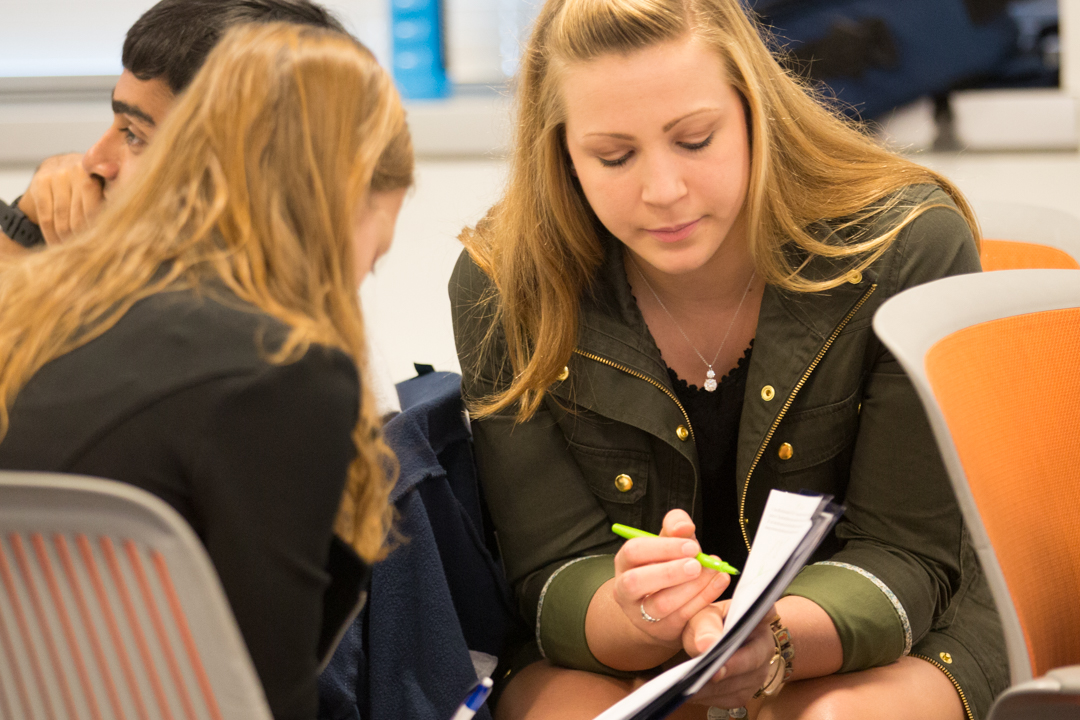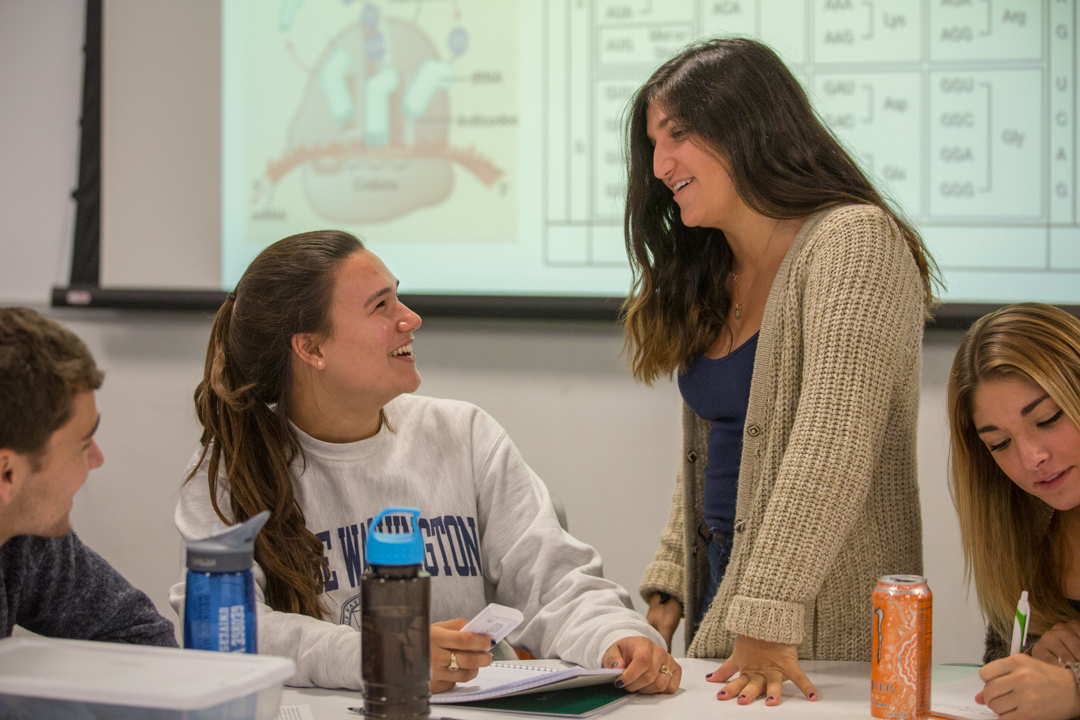In Robert Donaldson’s hour-long introductory biology course, his lectures rarely last more than 20 minutes.
“That’s about as long as students can pay attention,” said Dr. Donaldson, a biology professor at the George Washington University.
After giving a quick Powerpoint presentation on a Thursday in September, he turned off his microphone, passed out a worksheet and handed the class over to his students. Suddenly, the Monroe Hall classroom, where 81 undergraduates were seated around nine round tables, buzzed with excited chatter.
When freshman Nurbanu Davaz struggled to name the smaller molecules that are used in the process of transcription, junior Paige Tripp came to her aid.
“If you think it’s amino acids, then what is the product of transcription?” Ms. Tripp asked.
“Oh,” Ms. Davaz said after a pause. And then something visibly clicked in her head. “Oh, I see. I mixed it up.”
Ms. Tripp, a psychology major, is one of five learning assistants in Dr. Donaldson’s Biological Sciences 1111 course (their so-called “host classroom”). Her job is not to prepare homework, grade quizzes or guest lecture. Instead, she and the other learning assistants—or “LAs”—facilitate group discussions, encourage their peers to overcome learning challenges and provide feedback to their host instructor.
Since the peer instructors have all taken and passed the course in previous semesters, they have a pretty good understanding which parts of the material are the trickiest and how to help their peers master it.
The GW Learning Assistant Program—now in its third year at the university—is changing the way Dr. Donaldson teaches. And just one month into the semester, the LAs seem to be affecting how his students are learning as well.
“Paige really likes to work your brain,” said Ms. Davaz, who is studying biophysics. “She doesn’t just give you the answer, but she helps you re-think what you’ve learned and work through the problem. That’s how you comprehend the information. Biology isn’t just memorization. It’s comprehension.”
Throughout the semester, Ms. Tripp will stay assigned to the same 15 or so students. Not only does she help out in class, but she also makes herself available outside of the classroom.
“I think the biggest and most helpful thing I do is serve as a person that the students are more comfortable going to with questions,” she said. “I know that with a lot of my students, as soon as Professor Donaldson comes over, they just become silent.”
For self-described shy students, like Ms. Davaz, having a knowledgeable peer to turn to is a relief.
“Being able to ask the learning assistants questions, emailing them and talking on a normal, informal basis helps a lot,” Ms. Davaz said.
The Death of the Lecture
Recent studies have shown that lectures, especially in large science, technology, engineering and math (STEM) courses, aren’t just boring, they are ineffective. On the other hand, “active learning,” which includes group work and answering handheld clicker questions, can boost grades and help students retain material longer.
“Lectures can be good to inspire students and get them excited if we do a good job. But each time students are asked to take a quiz right after a lecture, they mostly fail it,” said Hartmut Doebel, who also teaches introductory science courses at GW. “Students have to work with the material, digest it, repeat it and look at it from different angles.”
A longtime biology professor, Dr. Doebel was accustomed to traditional lecture-style classes. But when he started noticing his students were spending more time scrolling through Facebook and Amazon than paying attention to his lessons, he, like many college professors throughout the country, began searching for a new, innovative teaching strategy.
In 2012, he teamed up with fellow Columbian College of Arts and Sciences Professors LaKeisha McClary and Jerry Feldman, and Tiffany-Rose Sikorski, an assistant professor in the Graduate School of Education and Human Development. Together, the faculty co-founded GW’s Learning Assistant program, based on a model developed at the University of Colorado Boulder. After a year of planning, the GW LA program launched in fall 2013 with funding from the Teaching and Learning Collaborative. The following year, the program received a grant to expand to foreign language classes with the help of Margaret Gonglewski, an associate professor of German.
Each learning assistant is a talented undergraduate chosen by his or her professor to participate in the program. STEM learning assistants receive a small stipend after completion and foreign language learning assistants receive course credit.
This semester, there are 35 STEM learning assistants paired with 11 host instructors across six different departments. By December, the program will have trained 91 learning assistants in total. GW is one of more than 80 LA sites across the country.

Learning Assistant Hannah Kopydlowski, a Columbian College junior, helps a student with a problem. (Zach Marin/GW Today)
A key difference between learning assistants and teaching assistants is the training aspect of the LA program. During their semester as peer instructors, all STEM learning assistants are simultaneously enrolled in a graduate-level pedagogy class taught by Dr. Sikorski, an assistant professor of curriculum/pedagogy and a former high school science teacher.
“The learning assistants are specifically prepared to understand students’ ideas about science, how they reason and how to facilitate high-quality discussion,” Dr. Sikorski said.
The foreign language LAs—five, this semester—are enrolled in a pedagogy class with Dr. Gonglewski. Though the language learning assistants function differently from their STEM counterparts, they provide an equal level of aid to their peers. There are no lectures in language courses, but the LAs share the responsibility of keeping students actively engaged in their learning during class, interacting with them during group work and serving as role models.
“I’ve received a lot of feedback from my students who have said it is a relief to have someone in class who has been in their shoes,” Dr. Gonglewski said.
For both the language and STEM host instructors, having learning assistants often means relinquishing a good bit of classroom control. In addition to cutting down lecture time, Dr. Donaldson has done away with multiple-choice exams and instead assesses student learning with short answer questions, similar to the worksheets he hands out in class. In Dr. Doebel’s classes, students are permitted to work in groups during tests.
Anecdotally, Dr. Doebel said he has noticed more enthusiasm and participation from his students since the LA program began. And the data show that peer instruction improves student grades.
Based on tests taken at the beginning and end of a Physics II course, a 2014 study from the University of Colorado Boulder showed that students enrolled in classes with learning assistants demonstrated learning gains double, or in some cases triple, that of their peers in traditional lecture courses. Preliminary studies conducted at GW have yielded similar results.
“I like that we, as instructors, are forced to create a horizontal structure. We need to listen to the feedback of our learning assistants. They have ideas. They are able to guide the students sometimes more than we are,” Dr. Doebel said. “That’s a wonderful experience to see how that works.”
The Benefits of Teaching
Earlier this semester, Dr. Sikorski, who teaches the pedagogy course for STEM learning assistants, assigned her students to film their host classrooms. During her Thursday evening education course, the LAs took turns reviewing a transcript from one of the videos and identifying different “mental models” or the way students think through problems.
For some LAs, the program offers an opportunity to become better students.
“I plan on hopefully studying more languages after German. And having the awareness of different teaching methods and how different people learn certain languages will definitely be helpful when I decide to take up, say, French or Swedish,” said Cody Van Dussen, a senior and German LA who is studying international affairs.
The program also has deepened learning assistants’ understanding of the subject matter they are teaching and strengthened relationships with their professors.
“You really have to know the content well enough to teach it,” said Danny Oler, a sophomore studying electrical engineering and an LA in a biophysics II course.
For others, the experience offers a fresh perspective on the classroom.
“You see how easy it is to know when someone hasn’t done the reading,” Ms. Tripp said. “I always thought you could kind of get away with not reading, and the professor wouldn’t know, but nope, it’s pretty easy to tell.”
Many also said that being a learning assistant has sparked an interest in becoming a teacher.
“Most students in my class are really excited. It really feels good when you see something click in their minds,” said Emily Mascarenas, a senior studying international affairs and a German LA. “I definitely want to teach now, though probably not right away.”
Dr. Sikorski said her team of faculty members is hoping to expand the Learning Assistant Program significantly over the next few years to reach more host instructors in more departments. This year, the LA professors are processing hundreds of hours of video data, surveys and assessments to assess the health of the program.
“I am so committed to this program,” said Dr. Sikorski, the excitement palpable in her voice. “I think all students should have the experience to really think deeply about what they’re learning and to collaborate with others, and the LA program facilitates that.”


